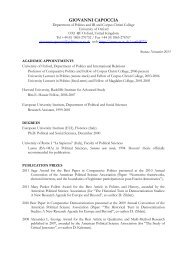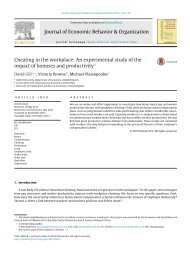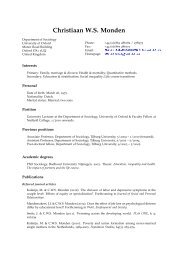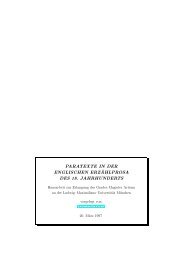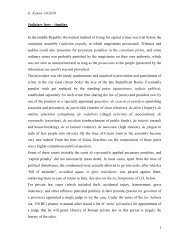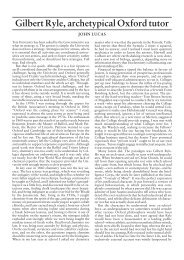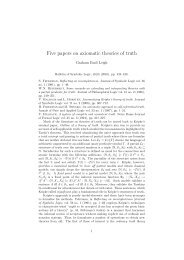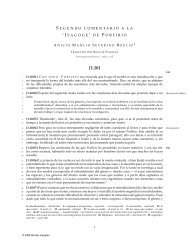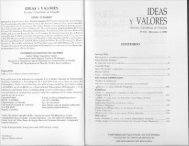Lexical Functional Grammar - Personal Pages Index
Lexical Functional Grammar - Personal Pages Index
Lexical Functional Grammar - Personal Pages Index
You also want an ePaper? Increase the reach of your titles
YUMPU automatically turns print PDFs into web optimized ePapers that Google loves.
⎡<br />
⎤<br />
PRED ‘DEVOUR〈SUBJ,OBJ〉’<br />
SUBJ [ PRED ‘DAVID’ ]<br />
[ ]<br />
SPEC A<br />
OBJ<br />
PRED ‘SANDWICH’<br />
⎧[ ] ⎫<br />
PRED ‘YESTERDAY’ ⎪⎨ ⎡<br />
⎤<br />
⎪⎬<br />
⎢<br />
ADJ PRED ‘AT〈OBJ〉’<br />
⎣ ⎣ ⎪⎩ OBJ [ PRED ‘NOON’ ] ⎦<br />
⎥<br />
⎪⎭<br />
⎦<br />
The same is true of XADJ: more than one XADJ phrase can appear in a<br />
single sentence:<br />
(16) Having opened the window, David ate the celery naked.<br />
Hence, the value of the XADJ feature is also a set of f-structures.<br />
The f-structures that have been presented so far have included only a subset<br />
of their functional features. In fact, it is common in LFG literature to display<br />
only those features that are relevant to the analysis under discussion, since a<br />
full representation would often be too unwieldy. A full f-structure for these<br />
sentences would contain at least the features and values listed in (17), and<br />
probably other language-specific features and values as well.<br />
(17)<br />
Feature Value<br />
Person: PERS 1, 2, 3<br />
Gender: GEND MASC, FEM, ...<br />
Number: NUM SG, DUAL, PL, ...<br />
Case: CASE NOM, ACC, ...<br />
Surface form: FORM Surface word form<br />
Verb form: VFORM PASTPART, PRESPART,...<br />
Complementizer form: COMPFORM Surface form of complementizer:<br />
THAT, WHETHER,...<br />
Tense: TENSE PRES, PAST,...<br />
Aspect: ASPECT F-structure representing<br />
complex description of<br />
sentential aspect. Sometimes<br />
abbreviated as e.g.<br />
PRES.IMPERFECT<br />
Pronoun type: PRONTYPE REL, WH, PERS,...<br />
The values given in this chart are the ones that are most often assumed, but<br />
some authors have argued for a different representation of the values of some<br />
features. For example, Dalrymple & Kaplan (2000) argue for a set-based representation<br />
of the PERS and GEND features to allow for an account of feature<br />
resolution in coordination, and of the CASE feature to allow for case indeterminacy.<br />
Some studies assume a PCASE feature whose value specifies the grammatical<br />
function of its phrase; in more recent work, Nordlinger (1998) provides<br />
9



